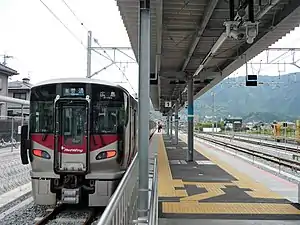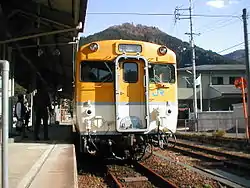| Kabe Line | |
|---|---|
 | |
 A 227 series train at Aki-Kameyama | |
| Overview | |
| Owner | |
| Locale | Hiroshima Prefecture |
| Termini |
|
| Stations | 14 |
| Service | |
| Type | Regional rail |
| System | Hiroshima City Network |
| History | |
| Opened | 1909 |
| Technical | |
| Line length | 15.6 km (9.7 mi) |
| Number of tracks | 1 |
| Track gauge | 1,067 mm (3 ft 6 in) |
| Electrification | 1,500 V DC, overhead lines |
| Operating speed | 65 km/h (40 mph) |
The Kabe Line (可部線, Kabe-sen) is a railway line operated by West Japan Railway Company (JR West) within the city of Hiroshima in Japan. It connects Hiroshima Station and Aki-Kameyama Station in Asakita-ku. The actual junction station is Yokogawa. It is one of the commuter lines to Hiroshima.
Route data
- Operator: West Japan Railway Company (Class-1 railroad)
- Official line length: 14 kilometres (8.7 mi)
- Gauge: 1,067 mm (3 ft 6 in)
- Double track: none (entirely single track)
- Electrified sections: entire line (1500 VDC)
- Safeworking system:
- special automatic occlusive (track circuit detection type)
History
Private railway
The section now in operation of the Kabe Line was originally constructed by a private company and later purchased by Japanese Government Railways.
The section was opened by Dainippon Kidō in four phases.
- 19 December 1909: Yokogawa Station to Gion Station
- 19 November 1910: Gion Station to Furuichibashi Station
- 25 December 1910: Furuichibashi Station to Ōtagawabashi Station
- 12 June 1911: Ōtagwabashi Station to Kabe Station
The line was handed over to Kabe Kidō on 11 March 1919. Kabe Kidō was merged to Hiroshima Denki Kidō on 1 May 1926.
The line was originally built to 762 mm (2 ft 6 in) gauge and not electrified. The line was electrified and re-gauged (to the national standard of 1,067 mm (3 ft 6 in)) in the following steps.
- 9 November 1928: Yokogawa – Furuichibashi section. Bus service temporary replaces rest of the line. Matsubara Station closes and Taishi Station opens.
- 10 August 1929: Furuichibashi – Shichikenjaya section.
- 2 December 1929: Ōtagawabashi – Kabe section.
The line was handed over to the Kōhin Railway on 1 July 1931. On 1 December 1935, the line's legal status was changed from light railway to railway.
After nationalization
The line was nationalized on 1 September 1936, and became a part of Japanese Government Railways as the Kabe Line. Simultaneously, some station names were changed as follows:
- Oshibakoenguchi Station to Mitaki Station
- Nagatsuka Station to Aki-Nagatsuka Station
- Ōtagawabashi Station to Kami-Yagi Station
- Nakashima Station to Aki-Nakashima Station
- Kōhin-Kabe Station to Kabe Station
The line voltage was raised from 750 V to 1,500 V (JNR standard) on 23 April 1962.
Since 4 September 1968, the line had been on the government's list of deficit-ridden railways where service was to be discontinued.
After JR West took over the line in 1987, wanman driver-only operation was introduced on the Kabe – Sandankyō section.
Beginning in summer 2007, the ICOCA card can be used in all stations in the Hiroshima City Network, including all stations on the Kabe Line.
On 4 February 2011, it was announced that a 1.6 km (0.99 mi) section of the abandoned segment, between Kabe Station and the former Kōdo Station, would be electrified and reopened. This will be the first such reopening by a JR Group company since the privatization of Japanese National Railways (JNR).[1] Operation was scheduled to resume from fiscal 2015;[2] the two new stations at Kōdo-Homachigawa and Aki-Kameyama finally opened on 4 March 2017.[3]
Discontinued/suspended section

JGR extended the line beyond Kabe Station. The extended sections were not electrified.
- 13 October 1936: Extension to Aki-Imuro Station completed
- 30 March 1954: Extension to Kake Station completed (on completion of this extension, the total length of Japanese National Railways exceeded 20,000 km or 12,400 mi.)
- 27 July 1969: Extension to Sandankyō Station, 60.2 km (37.4 mi) from Yokogawa, completed
The line was intended to be extended to Hamada station on the Sanin Main Line, and construction on that section commenced in 1974, before being abandoned in 1980.
The Kabe – Sandankyō section was closed on 1 December 2003.
- Operator: West Japan Railway Company (Class-1 railroad)
- Official line length: 46.2 km (28.7 mi)
- Gauge: 1,067 mm (3 ft 6 in)
- Double track: none (entirely single track)
- Electrified sections: non
- Closure system:
- section between Kabe Station and Kake Station: Special automatic closure type
- section between Kake Station and Sandankyō Station: Staff closure type
Stations
Trains can pass at stations marked "||", "◇", "∨", and "∧". Trains cannot pass at stations marked "|".
| No. | Station | Japanese | Distance (km) |
Transfers | Tracks | Location |
|---|---|---|---|---|---|---|
| Sanyō Main Line | ||||||
| B01 | Hiroshima | 広島 | Sanyō Shinkansen, Kure Line, Geibi Line, Hiroden Main Line | || | Minami | |
| B02 | Shin-Hakushima | 新白島 | Astram Line | || | Naka | |
| Kabe Line | ||||||
| B03 | Yokogawa | 横川 | 0.0 | Sanyō Main Line, Hiroden Yokogawa Line | ∨ | Nishi |
| B04 | Mitaki | 三滝 | 1.1 | ◇ | ||
| B05 | Aki-Nagatsuka | 安芸長束 | 2.6 | ◇ | Asaminami | |
| B06 | Shimo-Gion | 下祗園 | 3.9 | ◇ | ||
| B07 | Furuichibashi | 古市橋 | 5.3 | ◇ | ||
| B08 | Ōmachi | 大町 | 6.5 | Astram Line | | | |
| B09 | Midorii | 緑井 | 7.3 | ◇ | ||
| B10 | Shichikenjaya | 七軒茶屋 | 8.0 | | | ||
| B11 | Bairin | 梅林 | 9.6 | ◇ | ||
| B12 | Kami-Yagi | 上八木 | 11.2 | | | ||
| B13 | Nakashima | 中島 | 12.6 | | | Asakita | |
| B14 | Kabe | 可部 | 14.0 | ◇ | ||
| B15 | Kōdo-Homachigawa | 河戸帆待川 | 14.8 | | | ||
| B16 | Aki-Kameyama | あき亀山 | 15.6 | ∧ | ||
Rolling stock
New 2- and 3-car 227 series electric trains were introduced on the Kabe Line from around 2015,[3] replacing older 115 series trains.[4] By 2019, all Kabe Line services were operated by 227 series trains.[3]
References
- ↑ JR廃線、初の復活…広島市の可部線 [First-ever reopening of an abandoned JR line: the Kabe Line in Hiroshima]. Yomiuri Shimbun (in Japanese). 4 February 2011. Retrieved 6 February 2011.
- ↑ 可部線、15年度に延伸 [Kabe Line to be extended in fiscal 2015]. The Chigoku Shimbun Online (in Japanese). Japan: Chugoku Shimbun. 1 January 2013. Retrieved 8 January 2013.
- 1 2 3 "JR可部線、コロナ禍を経ても混雑が激化 - 2021年度の混雑率132%に" [JR Kabe Line faces increasing congestion in spite of coronavirus pandemic, with a 132% congestion rate in fiscal 2021]. Mynavi News (in Japanese). 23 July 2022. Retrieved 25 July 2022.
- ↑ JR西日本、広島地区に227系近郊形直流電車を投入 [JR West to introduce 227 series DC suburban trains in Hiroshima area]. The Page (in Japanese). Japan: Wordleaf Corporation. 19 June 2014. Archived from the original on 19 June 2014. Retrieved 19 June 2014.